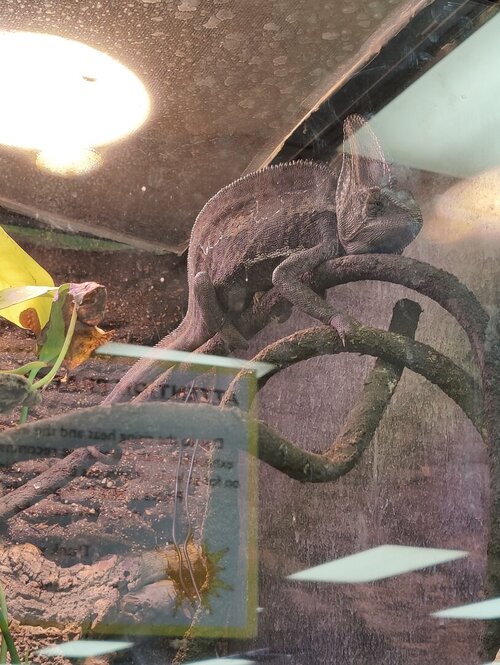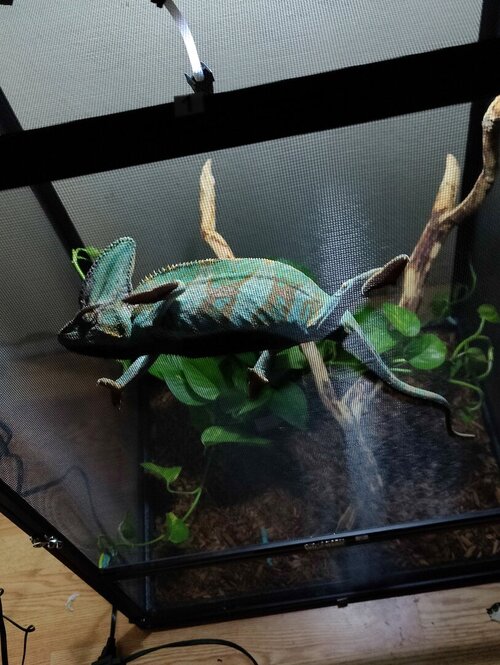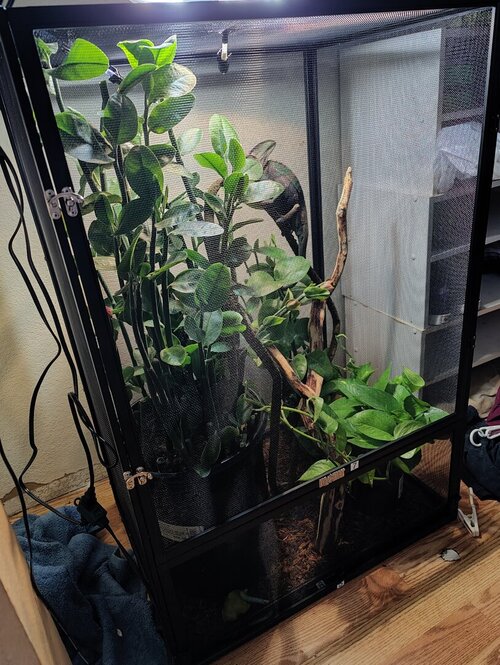Newveiledowner
Member
I just recently bought an adult veiled chameleon and when he is in the uvb and heat lamp he turns dark but when the lights are off he is his beautiful colors. The first day I brought him home I gave him horn worms and he ate about 3. Can someone give me some advice for a grown adult veiled chameleon? The picture of him dark is what he looked like when we bought him and also what he looks like when under the light. The picture of him green is what he looks like with the lights off. I also have a tall slipper plant in his enclosure because the reptile store I bought his enclosure from didn't really tell me what plants to buy. I just need some help first chameleon I bought and I bought him cause the petstore that had him he was in a glass cage and it was super small he barely had any room to move around in. Is a slipper plant okay for him? Please get back to me asap so I can make urgent changes if I need too! Edit added a picture of his enclosure
He is a veiled chameleon.
Think he is a male the pet store had no info other than price.
I've fed him the first day a couple of horn worms and the second day about 6 crickets no gutloading didn't know that was a thing till I came across this forum.
Watering was using a mister but it sucks so I'm going to change it in for a higher quality one today.
No droppings from what I can see hasn't been tested this will be the 3rd day I've had him.
It's a screen cage I've heard glass is bad for chams so I made sure I got that right.
For lights I am using zoomed 25w daylight blue and zoomed 5.0 uvb light.
The lowest temps are around 70f at night and during the day I'm not sure I need to get a temp gauge for when the lights are on.
Not sure what the humidity levels are.
Live plants they are called tall slipper plants.
Cage is in my room there is a fan but I have it off during the day no direct breeze towards the cage.
I have the cage on the floor in my room.
I live in phoenix arizona
He is a veiled chameleon.
Think he is a male the pet store had no info other than price.
I've fed him the first day a couple of horn worms and the second day about 6 crickets no gutloading didn't know that was a thing till I came across this forum.
Watering was using a mister but it sucks so I'm going to change it in for a higher quality one today.
No droppings from what I can see hasn't been tested this will be the 3rd day I've had him.
It's a screen cage I've heard glass is bad for chams so I made sure I got that right.
For lights I am using zoomed 25w daylight blue and zoomed 5.0 uvb light.
The lowest temps are around 70f at night and during the day I'm not sure I need to get a temp gauge for when the lights are on.
Not sure what the humidity levels are.
Live plants they are called tall slipper plants.
Cage is in my room there is a fan but I have it off during the day no direct breeze towards the cage.
I have the cage on the floor in my room.
I live in phoenix arizona
Attachments
Last edited:




